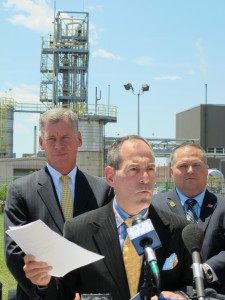DEP Secretary Krancer Stumps for Natural Gas Processing Facility in Delaware County

Susan Phillips / StateImpact Pennsylvania
DEP Secretary Michael Krancer at a press conference in Marcus Hook to promote the reuse of the Sunoco Refinery.
Department of Environmental Protection Secretary Michael Krancer took the microphone multiple times at a press conference this week aimed at promoting the conversion of the idled Sunoco refinery into a natural gas processing facility. Krancer wanted to assure any prospective investors that they would experience a friendly and expedited permit process.
“We as a Department of Environmental Protection will work hand in glove, very closely, cooperatively and spiritedly with anyone who would want to participate in activities at this facility,” said Krancer.
Krancer said DEP employees will “work night and day” to get industry the necessary permits.
“They’ll find a DEP that is creative and wants to get to the right result for environmental protection and economic development because the two are not mutually exclusive,” he said.
Krancer was speaking at a press conference unveiling a report done by the analyst firm IHS that looked at options for the idled Sunoco refinery in Marcus Hook, Pa. When asked, Secretary Krancer did say environmental concerns wouldn’t be short circuited.
“And the folks who are interested in this kind of facility,” said Krancer, “are not interested either in any short circuiting of environmental protections because they would need to live in this community.”
The proposed use options include the processing of natural gas liquids extracted from wells in the western part of Pennsylvania, and sold to the chemical industry. Any facility that processes gas would need to burn some sort of fuel in order to power the operations, which could create harmful air emissions. The refineries in Delaware County have had a long history of harmful air pollution. But Krancer focused his comments primarily on the economic benefits.
“This is the modern day equivalent of driving the golden spike at Promontory [Summit],” said Krancer, “which links East to West economically and infrastructure, and in every other way. And that’s how historic I think this moment it.”
On May 10, 1869 workers hammered in a final ceremonial golden spike at Promontory Summit, Utah, joining the Union and Central Pacific Railroads, creating the first transcontinental railway.
















